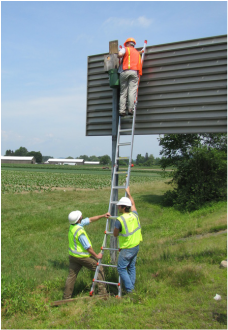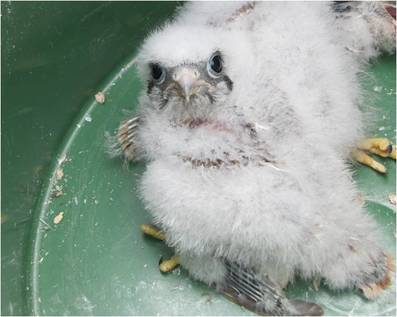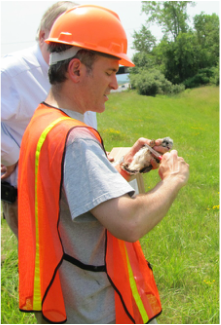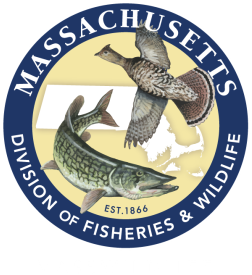American Kestrel and Highway Signs
Massachusetts’s smallest and most colorful falcon, the American Kestrel (Falco sparverius), also called a Sparrow Hawk, can be spotted hovering like a dragonfly or hummingbird in midair as it hunts insects, snakes, small birds, and mammals in fields and meadows. The expanses of open, grassy habitats adjacent to some roads provide suitable nesting areas for kestrels. Unfortunately, partly due to fewer expanses of grasslands, this beautiful bird’s population is dwindling not only in Massachusetts, but throughout the eastern United States. MassDOT and MassWildlife teamed up in a statewide American Kestrel conservation program modeled after a successful partnership between Iowa’s natural resource and transportation agencies in the early 1990s.
Like wood ducks, kestrels nest in tree cavities. With the program’s ultimate goal to increase kestrel nesting opportunities, the project entails installing kestrel nest boxes on the back of highway signs or on posts within highway right-of-ways and adjacent to grassy hunting habitat. Kestrel boxes built by Boy Scouts are donated to the program and then installed by MassDOT staff on suitable roadway habitat. In 2013, nine nesting boxes were installed in the Pioneer Valley and kestrels were found successfully nesting in one box, fledging five young. This year, three boxes were used for nesting and all were successful, producing 14 fledglings in total. This early success is extremely encouraging, and staff in both agencies plan to expand the program. Not only is this effort helping kestrels, but it is also a great way to raise awareness and engage the public on conservation issues and the habitat requirements of this little raptor.
Massachusetts’s smallest and most colorful falcon, the American Kestrel (Falco sparverius), also called a Sparrow Hawk, can be spotted hovering like a dragonfly or hummingbird in midair as it hunts insects, snakes, small birds, and mammals in fields and meadows. The expanses of open, grassy habitats adjacent to some roads provide suitable nesting areas for kestrels. Unfortunately, partly due to fewer expanses of grasslands, this beautiful bird’s population is dwindling not only in Massachusetts, but throughout the eastern United States. MassDOT and MassWildlife teamed up in a statewide American Kestrel conservation program modeled after a successful partnership between Iowa’s natural resource and transportation agencies in the early 1990s.
Like wood ducks, kestrels nest in tree cavities. With the program’s ultimate goal to increase kestrel nesting opportunities, the project entails installing kestrel nest boxes on the back of highway signs or on posts within highway right-of-ways and adjacent to grassy hunting habitat. Kestrel boxes built by Boy Scouts are donated to the program and then installed by MassDOT staff on suitable roadway habitat. In 2013, nine nesting boxes were installed in the Pioneer Valley and kestrels were found successfully nesting in one box, fledging five young. This year, three boxes were used for nesting and all were successful, producing 14 fledglings in total. This early success is extremely encouraging, and staff in both agencies plan to expand the program. Not only is this effort helping kestrels, but it is also a great way to raise awareness and engage the public on conservation issues and the habitat requirements of this little raptor.




